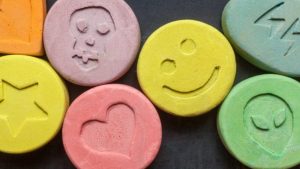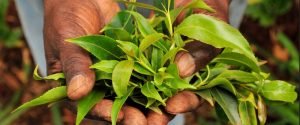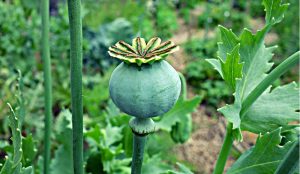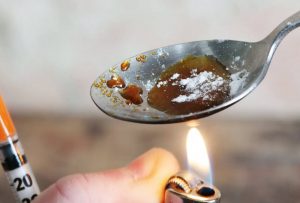Poppers is a slang term for various alkyl nitrites that are inhaled.
The most common poppers are isoamyl nitrite, isopentyl nitrite and isopropyl nitrite. Isobutyl nitrite used to be common in the European Union before it was banned there.
Back in the 19th century, amyl nitrite used to treat angina pectoris pains was sold in a glass capsule called a ”pearl”. To release the amyl nitrite, the pearl would be crushed. When this happened, a popping sound could be heard. The patient would then inhale the vapours released from the broken pearl. This popping sound is believed to be the origin of the slang term ”poppers”.
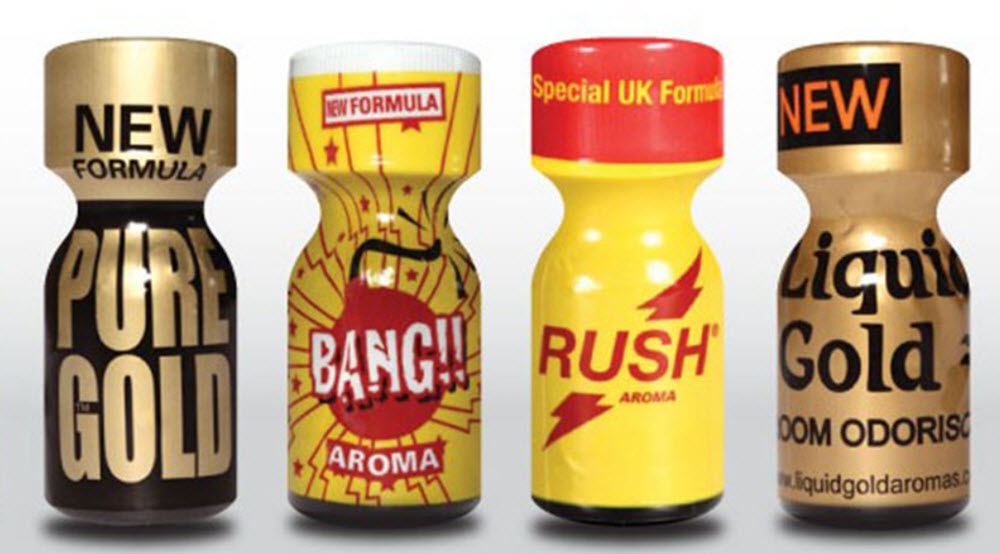
Administration route
Poppers are inhaled through the nose, either directly from the bottle or with the help of a small separate inhalator.
Effects and side effects
When inhaled, alkyl nitrates causes the smooth muscles throughout the body to relax, and the sphincter muscles of the anus and the vagina also become relaxed.
Smooth muscles surround the blood vessels, the blood vessels will expand when the muscles around them become relaxed. This expansion prompts the heart to beat faster and blood flow throughout the body is increased, giving the user a sensation of heat and excitment. The sensation will usually only last for a few minutes.
Examples of side effects
- Tachycardia
- Headaches and/or migraines
- Dizziness
- Fainting
- Eye damage, including retinal injury and centre-of-gaze damage
Interactions
When combined with other vasodilators, alkyl nitrites can cause a serious drop in blood pressure. This in turn can lead to fainting or even a stroke.
Examples of vasodilators are sildendafil (trade name: Viagra), vardenafil (trade name: Levitra) and tadalafil (trade name: Cialis).
Swallowing poppers
Swallowing poppers instead of inhaling them is more dangerous and can cause cyanosis, loss of conciousness, coma, and death.
Packaging
For markets where poppers are illegal, or where there is a social stigma attached to their use, it is quite common for manufactorers to package and label them to look like something else, such as tape head cleaner, leather polish or room deodorizer.
Chemistry of alkyl nitrities
These are some examples of alkyl nitrities utilized in poppers.
Alkyl nitrite | Formula | Appearance |
|---|---|---|
| Amyl nitrite (isoamyl nitrite, isopentyl nitrite) | (CH3)2CH(CH2)2ONO | Transparent liquid |
| Pentyl nitrite (n-pentyl nitrite) | CH3(CH2)4ONO | Yellow liquid |
| Butyl nitrite (n-butyl nitrite) | CH3(CH2)3ONO | Oily liquid |
| Isobutyl nitrite (2-methylpropyl nitrite) | (CH3)2CHCH2ONO | Colourless liquid |
| Isopropyl nitrite (2-propyl nitrite) | (CH3)2CHONO | Clear pale yellow oil |
Legal status
The legal status for poppers vary significantly between different countries. Here are a few examples:
- Poppers containing isobutyl nitrite are banned in the European Union.
- Poppers are not illegal in the UK, but selling poppers advertised for human consumption violates the Medicines Act of 1968.
- The purchase, sale or trade of amyl nitrite without the proper permit is illegal in Germany, Austria and Switzerland. Also, see the EU bann on isobutyl nitrite.
- Butyl nitrite poppers have been banned in France since 1990. Poppers with alkyl nitrite were briefly banned in 2007, but the bann was nullified by the Council of State.
- As of 2020, poppers are legal in Australia. They can be purchased in pharmacies as a schedule 3 substance without a prescription or as a schedule 4 substance with a prescription.
- Sale and distribution of poppers became illegal in Canada in 2013.
- In the United States, poppers with butyl nitrate were outlawed in 1988. In 1990, isopropyl nitrite poppers and other nitrite poppers yet not banned were outlawed by the Crime Control Act of 1990.
History
Discovery
The French chemist Antoine Jérôme Balard synthesized amyl nitrite in 1844.
Early medical use
In 1867, the Scottish physician Stir Thomas Lauder Brunton documented how an amyl nitrite inhalation could relieve pain when a patient with angina pectoris was experiencing chest pains. Brunton was inspired by earlier work with amyl nitrite carried out by Arthur Gamgee and Benjamin Ward Richardson.
In the late 1890s, Brunton documented similar effects for butyl nitrites, but they never caught on as a clinical alternative to amyl nitrates. Brunton also found that propyl nitrites worked in a similar way, but they also failed to become popular within the medical field.

Recreational use
The first documented case of recreational use of poppers is from 1964.
In the early 1970s, poppers became strongly associated with the gay community and with gay venues such as gay bars, discos and bathhouses.
In the late 1970s, both Time magazine and The Wall Street Journal ran articles where they noted that the practise of using poppers for sexual purposes had now spread from homosexual men to avant-garde heterosexuals. Poppers relax muscles various parts of the body, including the throat, anus and vagina. They also increase blood flow. Because of this, they are used in an effort to facilitate and enhance sexual experiences.
Poppers are also used for their (short-lived) high. Poppers were a part of the club scene in the 1970s and then migrated into the rave scene in the 1980s and 1990s.

